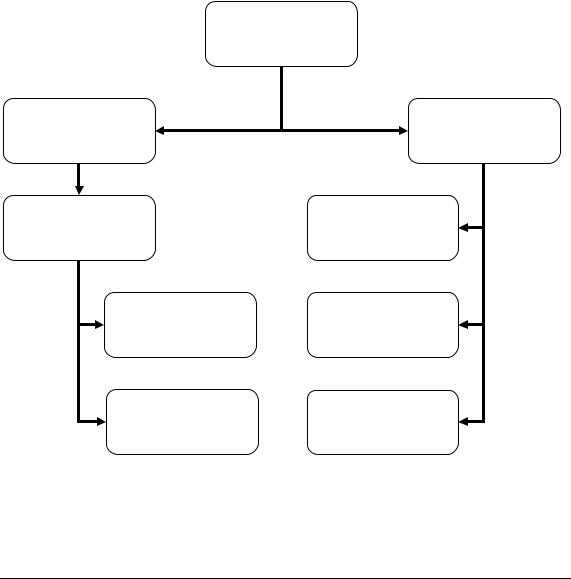
- •TABLE OF CONTENTS
- •INTRODUCTION
- •PLANNING FOR A PRESENTATION
- •Planning as a key factor for a successful presentation
- •Reasons for making a presentation
- •People in the audience
- •Venue and time
- •Subject matter and format
- •Task 2. Fill in the prepositions for, of, with, in, down, to, on, about.
- •Task 3. Complete the text with the words from the box.
- •Task 4. Read the information below and say if it is necessary to write out a presentation.
- •Writing and rehearsing the script
- •Task 5. Read the text below and find mentioned:
- •Visual aids
- •Rules for using demonstration material:
- •Task 6. Fill in the table using the sentences below.
- •Task 7. Look at the pictures below. Label the tools used to present visual information.
- •Task 8. Match the phrase on the left with the phrase on the right.
- •Task 9. Put the following mini-presentations into the correct order by putting a number in the space on the left.
- •Task 10. Choose the correct word to complete each sentence.
- •Task 11. Look through the checklist and the chart below and advise your group mate on planning and preparation of a presentation.
- •Checklist
- •PREPARING TO MAKE A PRESENTATION
- •UNIT 2. PRESENTATION PROCEDURE
- •Task 12. Read the information below and point out the presentation structure.
- •Features of the language
- •Structure
- •PRESENTATION STRUCTURE
- •INTRODUCTION
- •Opening courtesies
- •Task 14. Match a sentence or phrase on the left with one from the right.
- •Stating the target
- •Phrases of purpose
- •Task 15. Choose a verb from the box to complete each of the sentences below.
- •Providing an overview
- •Task 16. The following sentences are mixed up. Put the words into the correct order.
- •Stating the rules
- •Task 17. Complete the sentences with the correct word.
- •Task 18. Write down a possible phrase or sentence for each of the following. Use the words provided in brackets.
- •Task 19. Complete the following introduction with appropriate words.
- •Task 20. Work in pairs. Each of you should suggest a possible phrase for each of the prompts below.
- •Task 21. Use the notes below to prepare a brief introduction to a talk on safety for a manufacturing company.
- •Task 22. Give a one minute introduction only to a talk on any topic you like. If you cannot think of a topic, choose from the list below:
- •Task 23. Prepare an introduction to a short talk on one of the following:
- •Task 24. Read the information below and identify the following:
- •Main body of a presentation
- •MAIN BODY OF A PRESENTATION
- •Use of signalling words and phrases
- •Task 25. Choose the best word or phrase to complete each sentence.
- •Background information
- •Use of tenses for presenting background information
- •Talking about the past
- •Stating the situation in a particular area
- •Relating cause and effect
- •Task 26. Fill the gaps in the texts below with a word from the box (don’t forget to put the verbs into the correct tense form).
- •Task 27. Read the information below and say what is considered to be essential while presenting a problem of central concern to the audience.
- •Problem definition
- •Presenting a problem of central concern to the audience
- •Ways of introducing a problem
- •Task 28. Put the following words and phrases into the correct gaps in the paragraph.
- •Task 29. Read the information below and identify recommendations about speaking technique which can help the presenter to reach the target of a presentation.
- •Possibilities
- •Ways of presenting possibilities
- •Ways of criticising alternatives
- •Task 30. Complete the questions using a word from the box. Some words may be used more than once.
- •Task 31. Put each of the verbs into the past.
- •Task 32. Put the following questions into the correct order.
- •Task 34. Match a sentence or phrase from the left column with one from the right column.
- •Task 35. Fill the gaps in the sentences below with a preposition.
- •Task 36. Read the information below and point out:
- •Proposal
- •Stating a proposal
- •Ways of stating a proposal
- •Use of verbs to talk about possibilities and their results
- •Modal verbs for advice, opinion, suggestions and recommendations
- •Task 38. Choose one of the situations below to present a short extract from a presentation. Use linking expressions to connect the different parts of the talk.
- •Task 39. Use the information below to give a presentation of about seven minutes. Use listing, linking and sequencing where necessary.
- •Sales of GANI toys
- •Task 40. Prepare an informal presentation on a topic of your own choice.
- •Task 41. Read the information below and answer the following questions:
- •The end of the presentation
- •THE END OF THE PRESENTATION
- •Summary
- •Conclusion
- •Ways of summing up
- •Task 42. Complete each sentences by choosing the correct verb from the box. Make sure the verb is in the correct tense and agrees with the subject.
- •Task 43. Decide whether the sentences below are correct or not. Put C if they are correct and I if they are incorrect. Try to correct them.
- •Task 44. Read the information and say why handouts are advisable.
- •Handouts
- •Ways of presenting handouts and distributing them among the audience
- •Asking someone from the audience to help you
- •Closing courtesies
- •Thanks
- •Task 45. Complete the following sentences with the best preposition from the box.
- •Task 46. Match a phrase or sentence on the left with a phrase or sentence on the right.
- •Task 47. Complete the following using the appropriate words from the box.
- •Task 48. Choose the best word to complete each sentence.
- •Task 49. Look at the following overhead transparencies used in a presentation on safety procedures on an oil platform. Use them to reconstruct the end of the presentation.
- •Encouraging your audience to ask questions
- •Listening attentively to questions
- •Prepare for questions
- •Don’t preface your answer
- •Clarify
- •Amplify
- •Maintain your style
- •Be honest
- •Involve the whole audience in your answer
- •Employ the 25-75 % rule
- •Keep answers to the point
- •Acknowledge feelings, fact, or both
- •Respond with information
- •Maintain position
- •Questions from the audience
- •The speaker’s questions
- •Making sure the audience understands you
- •Answering questions from the audience
- •Making sure you understand the question
- •Task 51. Read the text and identify:
- •Open for questions: The silent disaster
- •A sales presentation
- •A Training Manager
- •Task 52. Handling questions is thought by many speakers to be the most difficult part of a presentation. Why do you think this is? How do you think difficulties can be minimized?
- •Task 53. Complete each sentence with a word on the right.
- •Task 54. Match a phrase on the left with the appropriate phrase on the right.
- •Task 55. Decide whether the sentences below are correct or not. Put C if they are correct and I if they are incorrect. Try to correct them.
- •Task 57. Put the following mini-texts in the correct order.
- •Task 58. Put the following sentences into the correct order.
- •Task 59. In which of the following situations do you think a discussion is more appropriate than questions?
- •Task 60. Imagine that you have given a talk on Marketing in Japan at a conference on business trends. What would you say in these situations?
- •Task 61. Divide into groups of four. Each person should prepare, in about two to three minutes, part of a short presentation on any topic he/she knows well.
- •For each contribution, respond appropriately.
- •Repeat the exercise until everyone in the group has been in the hot seat.
- •Task 62. Give the end of a presentation on a topic of your choice. Include either a summary or a conclusion and move to questions and / or discussion.
- •UNIT 4. EVALUATION, LEARNING AND IMPROVEMENT
- •Task 63. Read the text below and find:
- •Task 64. Read the information below and point out the main rules for receiving feedback effectively.
- •Feedback
- •Rule #1 – Don’t Get Defensive
- •Rule #2 – Don’t Try to Explain or Rationalize
- •Rule #3 – Get Specific
- •Rule #4 – Thank Them for the Feedback
- •Task 65. Answer the questions on the text.
- •Task 66. Read the text below and identify four rules for working with survey.
- •Task 67. Choose the correct word from the box below and put it into the sentence.
- •Likert scale
- •Task 68. Using the information below make up your questionnaire to conduct a survey.
- •Task 69. Put the text into the correct order.
- •Task 70. Evaluate your presentation using a 1-to-10 scale and the following criteria:
- •Task 71. Read the information below and point out the rules for making a successful presentation.
- •Task 72. Evaluate yourself. Check the category that best describes you as a speaker.
- •Task 73. Assess your current presentation skills.
- •REFERENCES

6.I’ll answer each question.
7.We must ask ourselves.
8.I’m sorry to say that.
f)the majority of customers were not satisfied with our services;
g)Managing Director;
h)and look at another answer to this problem.
Task 35. Fill the gaps in the sentences below with a preposition.
of |
with |
in |
for |
to |
on |
by out |
1.None _____ the options is satisfactory.
2.It’s an alternative ________ very little to recommend it.
3.I must warn you _______ the possible consequences _______ option A.
4.This alternative also has points _______ its favour.
5.It is also possible ______ the company ______ enter new markets.
6.Imagine that we merged ________the company.
7.I want to focus _______the five-year plan.
8.Let me begin ________ giving our terms of reference.
9.It’s my privilege today to be talking _____ this distinguished gathering
_____ professional experts ______the field.
10.I’m here today to sort _______ the future ______ the company.
Task 36. Read the information below and point out:
a)recommended techniques of stating a proposal;
b)ways of stating a proposal.
Proposal
Stating a proposal
The presenter should state a proposal, making it absolutely clear to the audience, giving the reasons why he/she thinks the recommended solution is true or correct.
When recommending a course of action it is particularly important to emphasize the right or even ideal solution as the presenter sees it rather than criticize the alternatives. It seems appropriate to suggest that now it is the time for action.
If the idea supported by the presenter has some weaknesses, it is advisable to make sure that these are presented in the first half of the argument, whereas all the persuasive factors are given in the second half.
ДВНЗ “Українська академія банківської справи НБУ”
32

Ways of stating a proposal
Well, where has all that got us to? The only satisfactory option open to us is option A.
The only option which can result in prompt action which is required is...
So, my recommendation is |
to reorganize... |
|
||
the first option, |
|
|||
|
|
option B. |
|
|
So, I |
|
recommend a reorganization. |
||
I strongly |
|
|||
|
|
|
||
|
|
the following. |
|
|
|
|
the following plan/idea/solution. |
||
I’d like to propose |
a merger. |
reorganize... |
||
|
|
that you |
||
|
|
should reorganize... |
||
|
|
|
||
The |
proposal |
is to try and reorganize the company. |
||
idea |
||||
|
|
|
||
I would suggest |
a reorganization. |
|
||
that we now reorganize. |
||||
|
|
|||
What I’m suggesting is... |
|
|
||
My suggestion is that we |
increase |
the price. |
||
should increase |
||||
|
|
|
||
We really |
think |
this is the best way to proceed. |
||
feel |
||||
|
|
|
||
I wish to make it crystal clear that this is the only way out under the circumstances.
This is our only option.
To put it briefly In a nutshell
the problem.
the difficulties in the area. there can be no better solution to the company’s financial
difficulties.
I hope you’ll agree that this proposal is the right one for the company.
ДВНЗ “Українська академія банківської справи НБУ”
33

Use of verbs to talk about possibilities and their results
Suppose
verb + subject |
+ present tense |
realistic possibility |
||
+ past tense |
more remote possibility |
|||
|
|
+ were to / should |
||
|
|
|
||
Suppose we don’t accept this option. |
|
|||
Let’s |
|
|
merge. |
|
suppose the two companies |
merged. |
|||
Just |
||||
|
|
were to merge. |
||
|
|
|
||
Supposing the company should go bankrupt, what would you do then?
Propose, suggest
The two verbs are used in exactly the same way but propose is slightly more formal than suggest.
|
+ noun / pronoun |
verb |
+ gerund |
+ (that) subject + present tense |
|
|
+ (that) subject + should + bare infinitive (formal) |
|
+ (that) + noun / pronoun + (should) + passive infinitive |
We propose a reorganization of the company. I would suggest reorganizing the company.
I propose that we reorganize the company.
I suggest that we should reorganize the company (formal).
We propose that the company (should) be reorganized (formal).
Advise, recommend
verb
+ noun / pronoun
+ gerund
I recommend a merger with another company. We advise reorganizing it at once.
Also:
I would strongly recommend that you reorganize the company. I would strongly advise you against it.
I advise you to accept the proposal.
Expect, forecast, foresee, predict
verb
+ noun / pronoun
that + subject + future tense
ДВНЗ “Українська академія банківської справи НБУ”
34

We expect changes in their strategy.
I predict good prospects for the company next year.
We foresee that the market will decline in the nearest future. We forecast that they will be pulled out of the market.
expect + object + infinitive
We expect the high inflation rate to last for a month.
Modal verbs for advice, opinion, suggestions and recommendations
must
ought to for advice and necessity should
You should proceed with new development projects under the circumstances. You haven’t much option in the matter. You must take on this new development project.
The company must conduct research in this area if it wishes to survive.
cannot or can’t |
|
(as the negative of “must”) |
|
may/might |
to express probability and certainty |
must |
|
will |
|
It is my view that the company cannot survive.
I feel that the results may be disappointing.
This, in my opinion, must be the best course of action.
My feeling is that the company will survive.
could to suggest doing something
You could go into research.
This could help the company improve the situation.
you might + like/want/wish |
for very polite suggestions |
||
You might like |
|
|
|
I thought you might |
want |
to reconsider our offer. |
|
wish |
|||
|
|
||
it might be |
+ a noun group |
for very polite suggestions |
|
+ an adjective group |
|||
|
|||
It might be a good idea I think it might be wise
to merge with another company.
ДВНЗ “Українська академія банківської справи НБУ”
35

Use of conditional sentences to consider a possible situation or course of action and try to decide what the results might be.
When there is a realistic possibility:
we’ll enter
If we choose option B, the original equipment market. we enter
When the possibility is more remote, or unlikely:
If we chose option C, we would have to increase efficiency.
Task 37. The information below is part of a Product Manager’s notes for a presentation on an advertising mix for a new range of beauty products, with the brand name Cheri. He is talking to a marketing team set up to promote the new range. Use the notes to give a short summary of the information using the active vocabulary.
Advertising mix for Cheri beauty products
Above-the-line |
Below-the-line |
advertising |
advertising |
- television commercials; |
|
In-store, e.g. |
- newspaper advertising; |
|
displays, merchandising, |
- magazines |
|
free samples |
|
youth |
On-pack, e.g. |
|
coupons, competitions, |
|
|
magazines |
|
|
joint promotions |
|
|
|
women’s |
targeted |
magazines |
mailing |
Begin as follows:
“Good morning, everyone. I’d like to talk about the advertising mix for the new Cheri range of beauty products. We are planning two categories of advertising, above-the-line and below-the-line. I’ll talk first about…..”
ДВНЗ “Українська академія банківської справи НБУ”
36
